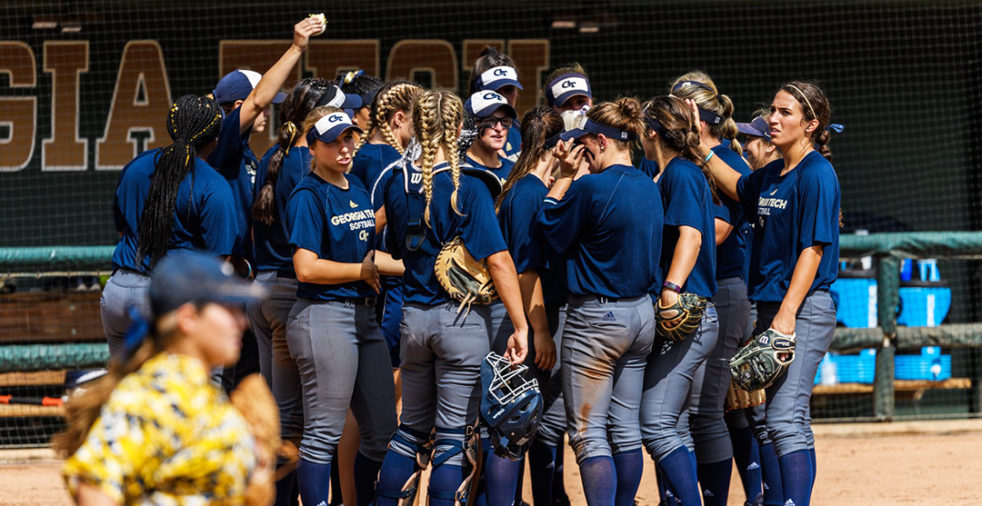While their counterparts across Fowler Street began play just a week ago, Tech softball’s season has been in full swing for most of February. Already 5-4 on the season, Tech softball rebounded from a pair of tough-luck losses to the Providence Friars to win four straight leading into the ACC/Big Ten Challenge, in which Tech swept Michigan but dropped a pair to a high-powered Illinois offense. Tech’s non-conference schedule includes games against Hofstra, Fordham and rival UGA before Tech begins ACC play against Virginia Tech on March 8. Here’s how Tech softball stacks up on both sides of the diamond moving forward.
THE BATS
It is impossible to talk about Tech softball without mentioning Tech’s offensive MVP from last season, Cameron Stanford. Stanford led Tech in batting average, on-base percentage, slugging percentage and doubles, and was named to second-team All-ACC, freshman All-ACC and the academic All-ACC team — quite the feat for someone in her first season of collegiate play. Not to be outdone, then-junior Katie Krzus hit .284/.394/.500 and led or tied for the team lead in HR and RBI, forming the potent core of Tech’s otherwise lackluster offense last season along with now-graduated Draven Sonnon.
Despite a slow start to the season for Stanford — who was hitting just .167/.310/.375 on the year entering Wednesday — Tech’s offense has been firing on all cylinders so far, as the Jackets have averaged 7.8 runs per game to date. That figure represents a vast improvement from Tech’s sputtering last season, where Tech collectively hit .227/.345/.396 and averaged just 4.3 runs per game. Through nine games, Tech has scored 70 runs to date in nine games — but it took them fifteen games to reach the milestone last season.
Leading the charge this season at the plate for the Jackets are sophomore Breanna Roper, who has posted an eye-popping .485/.486/.758 slash line with 16 hits in 9 games, and Krzus, whose 1.000 slugging percentage is tied for a highly impressive No. 29 in the country among Division I softball players.
Sophomore transfer Tricia Awald has also demolished opposing pitching, ranking second to Krzus in home runs and tying with Krzus and Roper for the team lead in total bases. Awald ranked as one of the top freshman in the nation while playing for the Kennesaw State Owls last season and was named Atlantic Sun conference freshman player of the year before transferring to Tech for this season.
It is a remarkable turnaround for a team that struggled so frequently at the plate last year. Part of it may have to do with cutting down on whiffs; Tech players struck out in nearly 25 percent of at-bats last season, but that figure has nosedived to just 18 percent this year. Tech’s offense needed a serious injection after last season, and to date it looks as if it has been completely revolutionized.
THE ARMS
In a sport where just one player might shoulder the pitching load for the entire team, Tech’s pitching appears lost without last year’s starter Emily Anderson, who threw 244 innings for Tech last season, 66 percent of the team’s total. Anderson pitched to a 2.24 earned run average and recorded six complete-game shutouts en route to being tabbed to her first second-team All-ACC appearance in her final year of eligibility.
Tech’s primary starter this season has struggled in comparison to Anderson’s dominance. Junior transfer pitcher Morgan Bruce has started five of Tech’s nine games to date and thrown to a 3.80 earned run average with a .243 batting average against. Bruce’s main issue to date has been control — the junior has averaged 4.8 walks allowed per seven innings, a noticeable spike from last season where Bruce averaged just 2.2 walks allowed per seven innings while pitching for Ole Miss.
North Georgia transfer Amber Johns has taken on much of the remaining load for Tech but has similarly struggled with control. While Johns has allowed just a .236 batting average against, Johns also leads the team in batters hit while recording just a 1.25 strikeout-to-walk ratio for Tech. It’s been an otherwise difficult transition to Division I play for Johns, who last season allowed just a 0.76 earned run average in over 111 innings and went undefeated for North Georgia.
Collectively, Tech pitchers have thrown to just a 5.19 ERA, .271 batting average allowed, 4.2 walks per seven innings and 1.4 home runs per seven innings — decidedly poor figures. Tech has traded one demon for another; while the offense has been nothing short of explosive to date, the Jackets’ pitching has noticeably suffered with the loss of Anderson, and the end result is that Tech has tread water thus far. Second-year head coach Aileen Morales has addressed the offensive deficiencies with a number of strong transfer recruits, but it is evident that Tech’s pitching requires considerable attention. If they get that right as the season goes on and the batting stays strong, the sky is the limit for this team.
